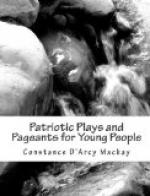SMITH
(standing center).
John Smith goes to Jamestown. John Smith friend
of great chief,
Powhatan. Palefaces always remember Powhatan!
Always remember
Pocahontas!
BRAVES
(all together).
Wah! Wah! Wah!
[Exit Smith, right. Smith is watched by the Indians in silence deep and respectful.
POCAHONTAS
(to Powhatan).
Great Chief safely returned. Captive set free.
Shall we go yonder?
(Points.) Pray to River God?
[Powhatan nods gravely. He and Pocahontas exeunt left. The braves follow next. The Indian maidens, women, and children form the end of the procession. The stage is thus left empty, and the scene ends.
COSTUMES
POCAHONTAS. Pocahontas should wear the traditional costume of “white doeskin with a scarlet mantle flecked with gold sequins.” A great chain of pearls should be about her neck. Another chain which reaches to her waist should be of white and blue beads—large beads that will catch glitter from the sun. About her head a band of tan, and a white quill. The embroidery about the neck of her Indian robe is of pearls. The basket which she carries should be white, with a motif of rich blue and scarlet. She wears a tan (dressed deerskin) girdle, heavily embroidered in red beads. Her stockings and moccasins are tan-colored also, the moccasins embroidered in scarlet. The ends of her braids are bound in scarlet and gold. White canton flannel, skilfully slashed for fringing, will make the Indian dress, which should fall in straight lines from a square neck. It should reach to about three inches above the ankle, and should be heavily fringed. The robe, worn fastened at the shoulders, should be of scarlet cloth. The deerskin belt is of cotton khaki. The moccasins can be made of the same material, cut sandal fashion. Or low canvas ties without heels, bead-embroidered.
CAPTAIN JOHN SMITH. Tan-colored costume of the seventeenth century. The coat of tattered, weather-stained brown velvet, the puffed sleeves slashed with tan satin that is soiled and frayed. Great tan boots coming to the knee. A white lace collar at neck, much the worse for wear. A brown leather girdle.
POWHATAN. Indian dress of tan (dressed deerskin), the neck and breast of it gorgeously painted with blue, green, and scarlet. Great chains of shells and beads. A huge head-dress of black feathers that hangs down his back almost to his knees. It should be the largest and most magnificent of all the Indian head-dresses, as it is the insignia of chiefdom. Tan stockings and tan moccasins. The material of his costume may be cotton khaki. (The imitation khaki is best, as the real material is too heavy.)
THE MEDICINE-MAN. The medicine-man is old. He wears a wig of long, white, coarse hair. His costume is of cotton khaki, decorated with beads, bits of looking-glass, and feathers. He wears no feathers on his head. A piece of fur is fastened to his shoulders. His blanket is black, with white cabalistic signs. It can be made of canton flannel.




